It’s been a while since I’ve done any kind of in-depth needlework product review. This particular tool has been on my radar for a while.
When a friend inquired about it recently, wondering if I had tried it and what I thought, I figured I’d take the plunge and purchase it. That way, you can know if it’s something you’re interested, and you can be aware of pros and cons before you purchase it.
The tool in question is the hoop floor stand by Nurge, a company that I think is located in Turkey, that’s recently made some inroads in the wider needlework market, especially in Australia and a little bit in the UK. Nurge products aren’t widely available in the US, but they are showing up here and there, now and then.
I’ve tried their hoops – I bought a set of them many months ago and I’m not quite sold on them compared to those I already use – but today, we’re going to take a look at their floor stand, which can hold most types of embroidery hoops.
The review goes into great detail, so if you have questions, read through the review thoroughly first and then feel free to ask anything you want to know in the comment section.
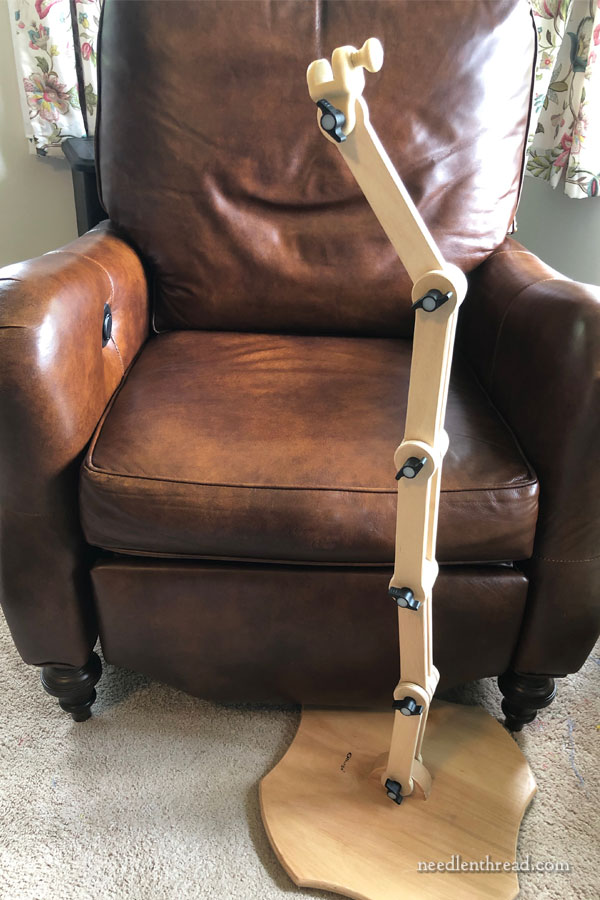
Right off the bat, be aware that this is a floor stand, primarily, but it can be used as a table top stand if you adjust all the sections in a way that makes the hoop accessible on a table top.
Still, I think that, given the construction of the stand and certain difficulties it poses, I wouldn’t want to make extreme adjustments on this stand frequently. For the price, which hovers under $70 in the US, I’d just leave it as a floor stand.
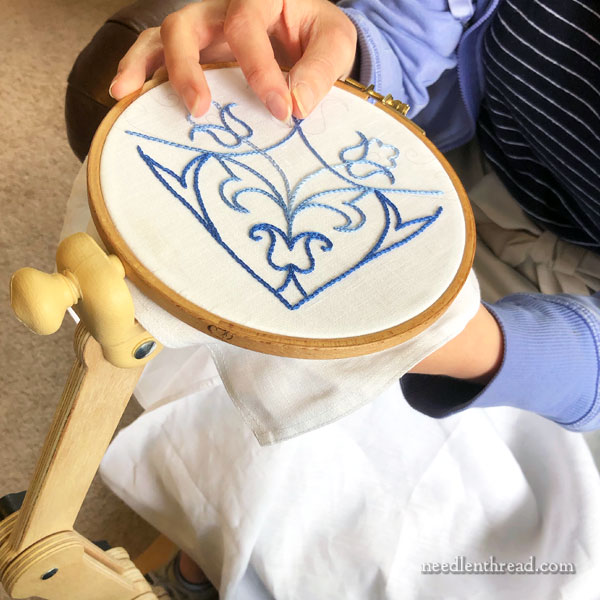
The whole point of a stand like this is to hold your hoop securely, without wiggling and jiggling and tilting about, so that both of your hands are free to embroider. And the stand does that, just as it’s supposed to do.
Your second hand might be underneath the embroidery, receiving the needle and sending it back up the surface (two-handed embroidery), or it might be managing a laying tool to help you create perfectly smooth or perfectly places stitches.
Or you might want a stand just to save yourself from having to hold a hoop! Some people like stands that hold their hoops and frames simply because they allow you to embroider more comfortably. Especially if you have any kind of hand issues – arthritis, swelling, anything like that – a stand will save your hands from stress and extra pain.
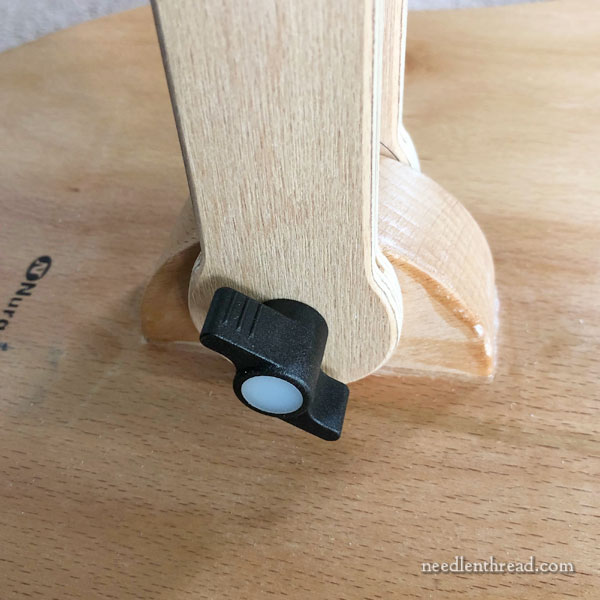
The Nurge stand is constructed with a broad, heavy-enough base with this little hump in it, onto which the spine of the stand is attached using these plastic wing-nut things to allow for adjustments.
You can see by looking closely that the finishing details aren’t great, but overall, the stand is finished ok. The wood is sanded smooth enough, and I didn’t encounter any splintering or anything like that.
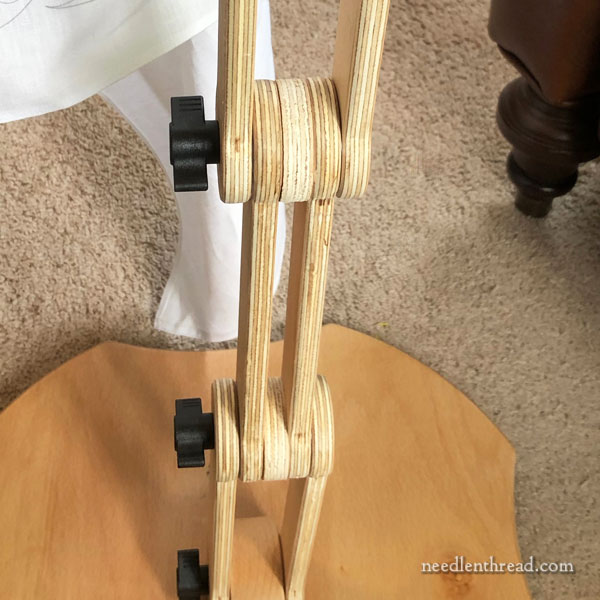
The spine is made up of five of these interlocking sections that can be adjusted using the plastic wing nut.
I do like the fact that this stand can be adjusted in a multitude of ways as a floor stand, with little nuances of change, to make it more comfortable to use. Compared to the straight, vertical, up-and-down floor stands that hold hoops, this adjustability seems to be an advantage.
A note on the adjusting: I find I have to tighten different sections occasionally, after use. The wing nut especially on the base of the stand seems to require the most attention. There are two soft plastic disks between the wood pieces at the base of the stand – I assume they are supposed to help keep the grip. It isn’t a huge problem at this point – the base tightens well enough – but just occasionally, I notice that it starts to slip a bit, so I give it an extra tightening up.
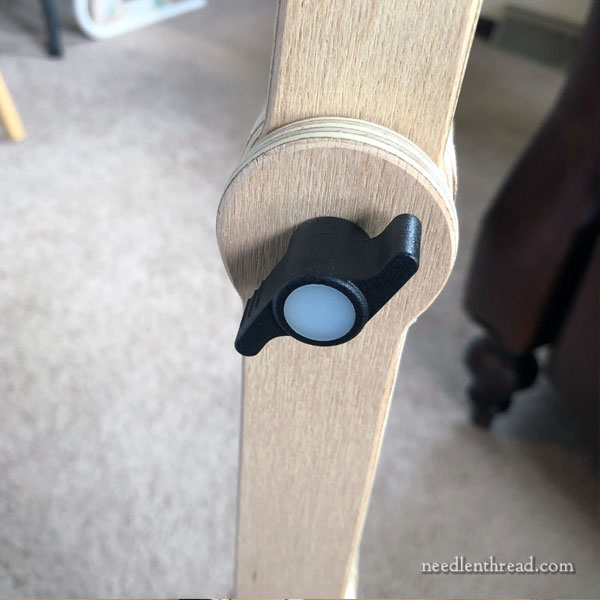
If you have hand problems like severe arthritis, you may find these plastic things hard to work with. When you tighten them, you really have to tighten them, and it can be stressful on sensitive hands. If you have tightened them quite tightly, they can also be difficult to loosen. I don’t have severe hand problems, but my fingers can get stiff and sore now and then, and when they are, I find the plastic wing nuts a little painful to adjust.
That said, once you have the stand in the general situation you prefer, and assuming your hands are functioning ok, just a little extra twist or tighten now and then will keep the stand in place for enough time to have a good stitching session or two without any problem.
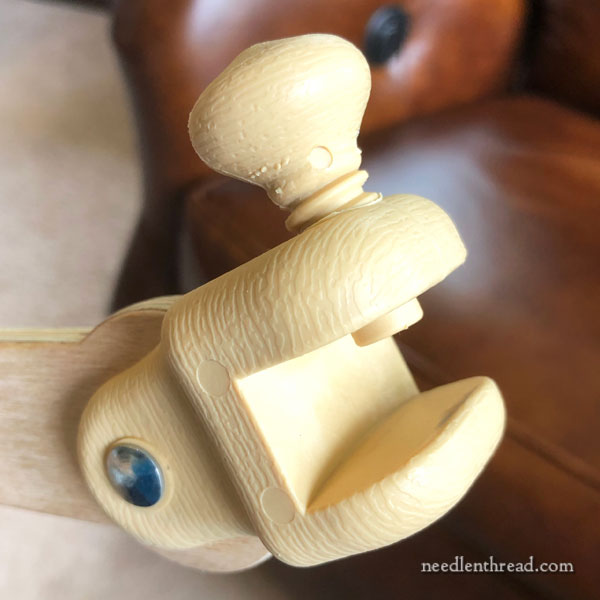
When you get to the head that holds the hoop, from a distance (or in a product photo), you might be tempted to think that it is wood. But it isn’t. It’s molded plastic.
So far, the head is holding up fine.
The head is the most difficult part of the stand to adjust. But you do need to adjust it. The “mouth” of the head needs to point practically straight up, if you want to work on a hoop that is parallel to the floor.
Once the head is adjusted to where you like it, it stays put. In fact, it is so hard to move, that you can’t really use it to flip your work upwards and away from you, to access the back of the hoop to end threads. I think it’s created with that concept in mind – that you can push the whole head upwards and away from you, to get the back of the hoop to stand straight up in front of you to end your threads – but it’s really too tight to move, even when you loosen the wing nut.
But I could be wrong altogether. Maybe the frame is not constructed with accessing the back of the work in mind at all.
In any case, to access the back of my work, I simply unscrew the plastic screw at the top of the head and remove my hoop. When I’m finished, I stick it back in and tighten it. There’s no difficulty or high science behind screwing the hoop into the head – it’s easy and quick.
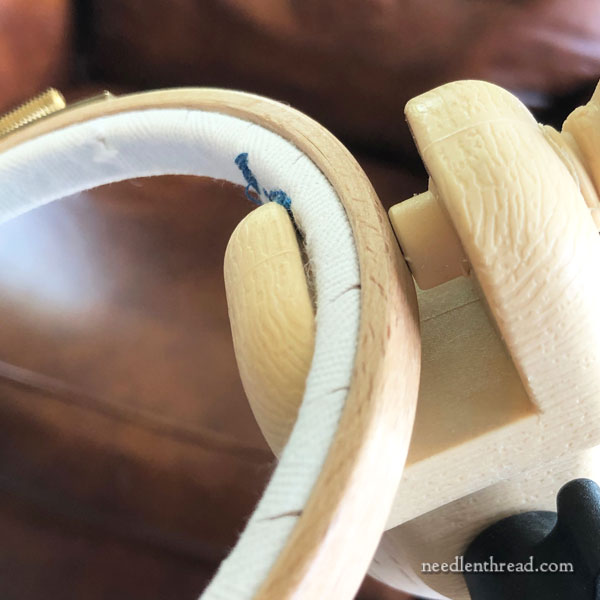
This is how the hoop fits into the head. It “bites” on the backside of the inside ring of the hoop, and the outside of the outermost ring of the hoop.
You can see, then, how this stand can hold practically any brand of normally styled embroidery hoop.
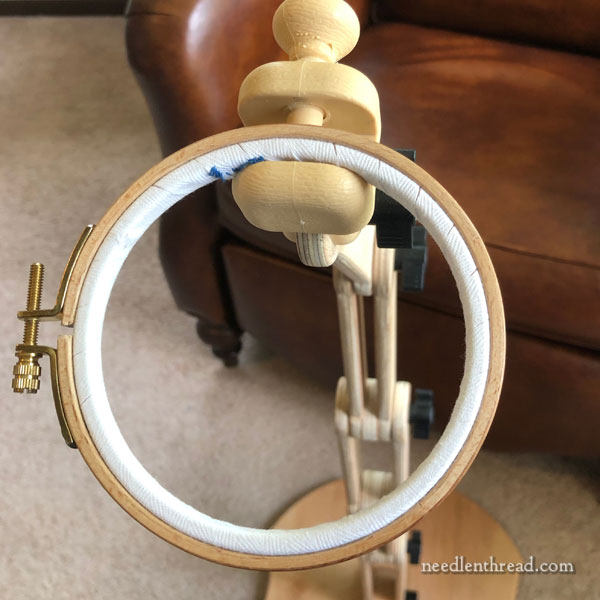
Obviously, the hardware area of the hoop can’t fit in the head, so you have to mount your hoop in the head anywhere else but where the hardware is. And in most cases, that is not a problem at all.
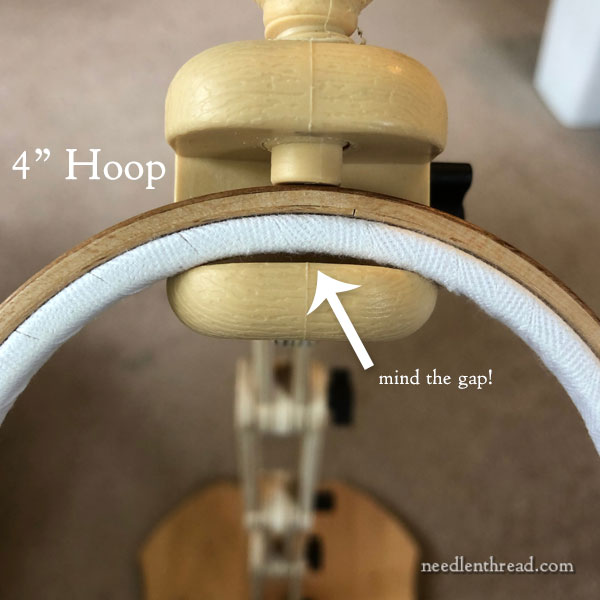
The stand will hold pretty much any size hoop.
That said, the smaller the hoop, the more of a gab there is between the lower jaw of the head and the inner ring of the hoop. Above, you can see a 4″ hoop in the head. Notice the gap.
It still holds the hoop well enough, but I do wonder if tightening that screw repeatedly (and you do have to really tighten it onto the hoop to get it to hold securely) will eventually warp a smaller hoop? I haven’t noticed that it affects the smaller hoops, but I’ve not used it frequently on 4″ hoops.
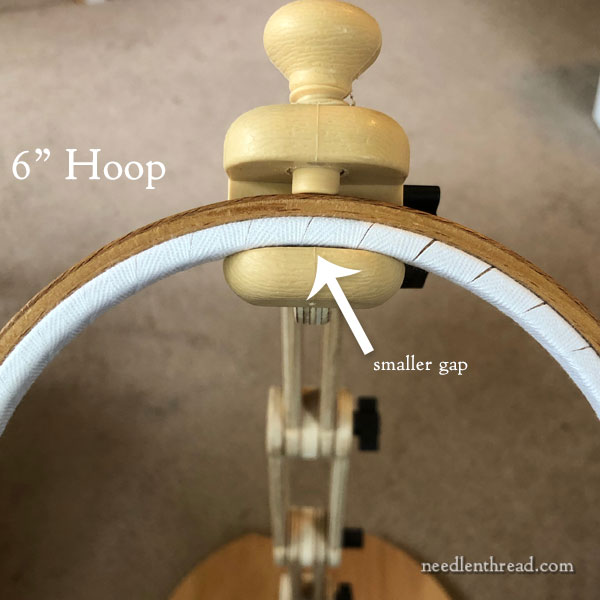
On a 6″ hoop, notice that the gap is almost nil.
Both of these hoops are 5/16″ Hardwicke Manor hoops (Klass & Gessmann hoops).
The narrower hoops – in this case, the 5/16″ hoops – fit in the mouth of the head, but the head tends to push on the back of the fabric that’s in the hoop, if you put the hoop all the way into the mouth. If you only catch the edge of the hoop in the mouth and with the screw, then the front edge of the head won’t push on the back of the fabric in the hoop.
Even if it does push a bit there, it’s not a lot, and it’s not going to affect your fabric in the hoop that much at all. Just be aware that with narrow hoops, the back of the fabric does come into contact with the head.
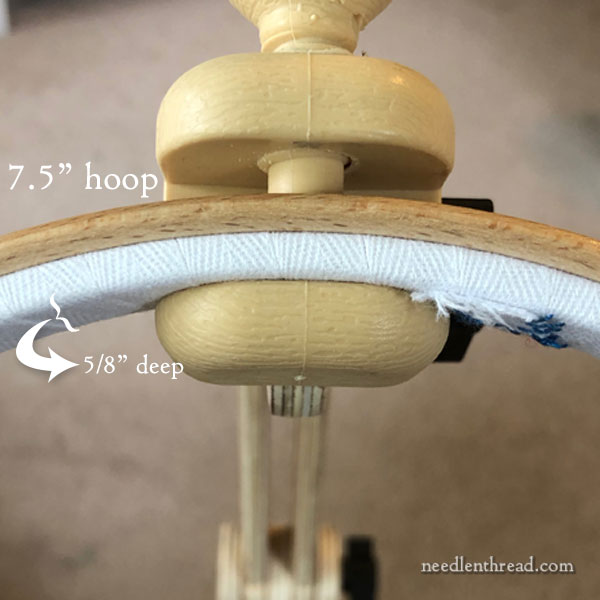
I’ve found that the 5/8″ deep Hardwicke Manor hoops work really well with this head – better than the thinner hoops (which is somewhat ironic, considering that Nurge’s hoops are thin).
So far, I’ve found that my favorite match, hoop-wise, with this stand is the 5/8″ deep, 7.5″ Hardwicke Manor (or Klass & Gessmann) hoop. It fits really well in the mouth without the edge of the mouth pushing on the back of the fabric, it gives me a good size hoop area for my embroidery, and the hoop with the fabric in it are not so heavy or large as to cause the stand to loosen at any of the joints.
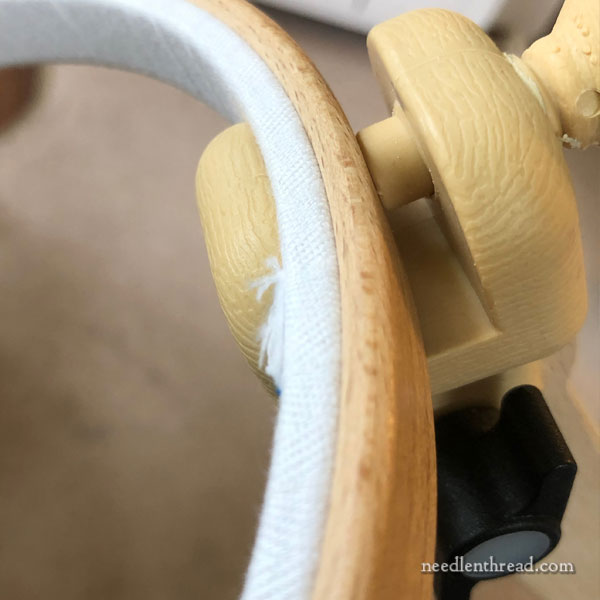
You can see here that the 5/8″ deep hoop extends beyond the edge of the mouth.
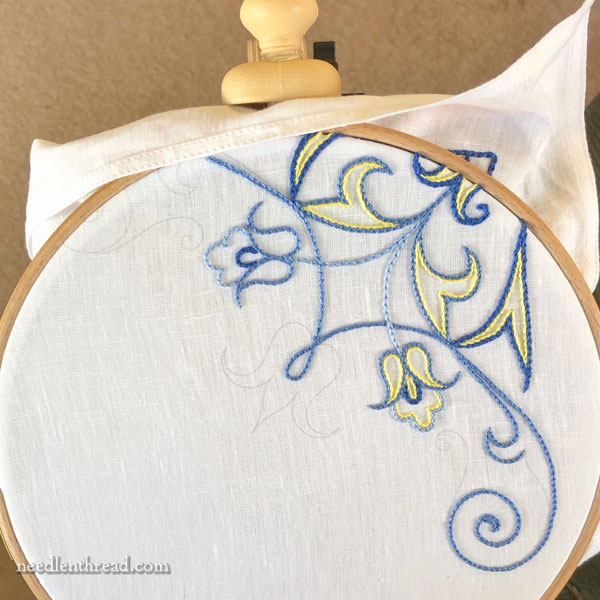
Be aware that, when your embroidery fabric extends well beyond your hoop (say you’re embroidering something large, like a table cloth or something similar, and you have a lot of excepts fabric around your hoop), you’ll have to fold your fabric upwards so that there’s one layer of excess fabric between the screw and the hoop, and then the rest of the excess has to drape over the head and the top of the stand.
Again, nothing bad here, necessarily. As long as that plastic screw is clean, and as long as there’s no really dimensional embroidery stitches that end up between the screw and the hoop, there shouldn’t be a problem. You can always adjust the placement of the hoop, but if there’s a lot of excess fabric, you do have to manipulate the fabric so that the hoop will fit in the head.
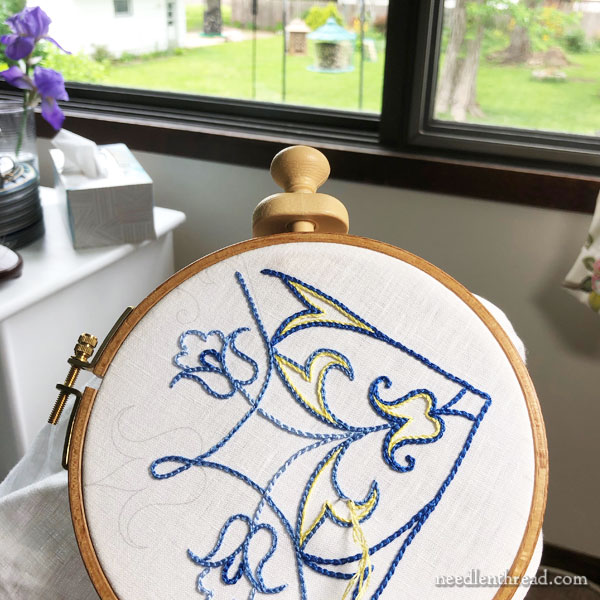
Here’s a list of pros and cons, to put things in a nutshell.
Pros
Here are points I consider pros:
1. The stand works. It holds hoops, and holds them well, so that you can have both hands free when you stitch.
2. It is constructed well enough – maybe not perfect in the finishing details, but I had no problems with rough wood, splinters, or anything on mine.
3. It doesn’t tip and it’s easy to move around – not super heavy, but heavy enough and broad enough at the base that it doesn’t tip.
4. It has multiple points of adjustment, so that you can achieve the most comfortable situation of the stand for you.
5. It is affordable, clocking in under $70 in the US.
6. It is collapsible for storage and for travel.
Cons
And here are the points I consider cons:
1. You can’t access the back of your work without removing the hoop from the mouth and then repositioning the hoop once you’re finished with the back.
2. The wing nut things are a bit hard on the hands, especially for those who have hand problems (which is often the reason people look for a stand).
3. The stand occasionally needs readjusting and tightening with normal use.
4. The head is hard to move. But on the bright side, once it’s where you want it, it’s not going anywhere.
Where to Find It
In the US, you can find this particular Nurge floor stand available on Amazon. If you visit my Amazon Recommendations page here, it’s listed under Embroidery Tools & Accessories. I’ve also listed the Nurge sit-on / table stand there. The floor stand goes in and out of availability, it seems.
I haven’t found any locally owned needlework shops that carry them in the US.
In Australia, Create in Stitch carries them, as well as other needlework shops around the country.
In the UK, this particular configuration seems to be sold or listed as a table stand. I’ve seen it in Etsy shops in the UK and sometimes it shows up on Amazon. I’ve not found it online through locally owned brick and mortar shops, but that doesn’t mean it isn’t there. Ask about or check your favorite shop!
This article contains an affiliate link to my Amazon Recommendations Page, which means that purchases made through that page result in a small commission for Needle ‘n Thread with no extra expense to you.







Good Morning Mary,
Your reviews are always so informative and helpful. I wonder if you know of a stand that is good at holding a q-snap frame. I have a K’s creation stand. I can’t seem to get it tight enough to hold the frame steady. Any suggestions?
Thank you,
Nancy
No, it won’t hold a q-snap. Needlework System 4 makes a q-snap head, but it isn’t inexpensive!
Mary that is an informative article. I’m wondering – could you attach a strip of sponge foam to help with the gap?- say, with Velcro maybe?
It works fine with the gap. I just wouldn’t want it to warp the smaller hoops, but so far, I haven’t had a problem.
Hi Mary,
I don’t think you are supposed to place the hoop into the head like it’s shown in your review. As seen in some official product photos, the screw is 90° more toward the stitcher if I’m not mistaken. That way the gap you noticed shouldn’t appear. Have you tried that? Anyways… Every stitcher can place the hoop however he/she likes. I just don’t think it’s meant/built to work that way. 😉
Hi, Ann – it’s in right. 🙂
Just to clarify, if you try to clamp this onto the edge of your hoop, it does not stay as firmly fixed in the head. Here’s a product photo that shows the same configuration: https://pin.it/5LyhnHZ
Also, this gal has an interesting video showing how they work: https://youtu.be/Pj-eXncqvcQ
The Pinterest pic shows the way I was trying to describe, the video doesn’t. I came across it at their Etsy shop. Don’t know if I’m allowed to post the link here. But if not, you can edit it out, right? 😉
https://www.etsy.com/de/listing/688529560/nurge-adjustable-embroidery-table-stand
But if you say it’s not tight enough that way… The little knob between the clamps irritates me either way. Wondering if it’d work better without it.
The little knob is the clamp. That is the difference. The “jaws” don’t go up and down.
Hi Mary, would this stand work with a smallish (about 10 inches square) frame? It looks like it might. My stand has broken and I’m attempting to work with a cobbled together system of broken bits, so a reasonably cheap replacement that I could get delivered through Amazon would be great.
Thanks
Jacky
It depends on the thickness of the frame sides. But in most cases, I would say no. It’s not meant for frames.
Could you compare this to the Needlework System 4 that you’ve reviewed before? I was hoping to try out the System 4 on a trip to Seattle this spring, but that is not put off indefinitely. Does the System 4 take an embroidery hoop? If so, any advantages/disadvantages over the Nurge stand?
Well, the Needlework System 4 will be more versatile. You can use the frame clamp on that to hold hoops, but you can also use it to hold stretcher bar frames, slate frames, and the like. You can’t use the Nurge stand to hold anything but hoops.
I am certain the NWS4 stand will hold up longer, overall. Wood stands tend to wear after a few years of use, making it hard to maintain tight joints. I’ve been using my fist NWS4 stand for well over a decade almost daily and it is still stellar. I don’t think this wooden stand will last quite as long. Time will tell, but I’ve never had a wooden stand last more than 3 or 4 years with heavy use. Still, for the price, if you’re just looking for something to hold a hoop, it’s not bad. If it lasts 3 or 4 years, that’s $20 or less per year for a stand that does what it’s supposed to do. The NWS4 will end up costing you almost $300. So it depends on how much you want to invest in a stand, how much versatility you need, etc.
If you’re planning to use stretcher bars or other embroidery frames in the future, definitely go for the NWS4, if you can afford it. That’s where you’ll have more options.
If, however, you only plan to use hoops, and if you are limited in your budget, then this might be the one to go for, for now – and then you can upgrade later if your interests or circumstances change.
Thanks so much for the comparison, Mary! Good to know that the frame clamp for the Needlework System 4. The description on Threadneedle Street doesn’t mention a hoop at all, so I wondered about that. I wish I were able to try this out in person, especially given the no return policy, but I think I might just take the plunge.
Well, it’s not really sold to hold hoops, but you can use hoops with it. I use hoops with mine frequently, and I know other stitchers who use the NS4 frame clamp solely for hoops.
Hi Mary, Ann has a point. These 4 links show the hoop inserted like it would be on an Elbsee stand and other stands. It might be worth trying. Even if the manual that came with the product says otherwise, if they just copied the construction of other stands they may not have figured out the best way to actually use it. Thanks so much for the review as it is nice to see an affordable product like this.
http://store.thequiltshow.com/Adjustable-Seated-Embroidery-Stand-p/nurg-kit-embs.htm
https://theembroiderer.co.nz/products/nurge-adjustable-seating-embroidery-frame
https://www.amazon.co.uk/Nurge-Adjustable-Embroidery-Holder-Tapestry/dp/B07RK4GSWS
https://www.ebay.com/itm/Nurge-Adjustable-Seat-Embroidery-Stand-Holder-Cross-Stitch-Tapestry-Hoop-Ring-/323712851778
I understand that the “clamp configuration” of these types of hoop stands is the common way to see them work.
There’s a big difference between the Elbesee and the Nurge. The Elbesee that has a clamp has “jaws” that open and it uses a screw mechanism to close the jaws, and the whole jaw clamps onto the hoop – there’s a lot more contact area to hold the hoop steady. On this stand, the “clamp” doesn’t exist. There is only the base of the plastic screw holding the hoop (no matter what configuration you use it in) against the base of the “mouth”, which is made out of molded plastic and doesn’t move, either. The base of the screw does not offer a stable or large enough area to hold the hoop as firmly in place if you try to use it like the Elbesee clamp. You can use it that way if you want, but it is simply not as stable. You could not use the Elbesee clamp the way shown above (obviously), but this configuration works well with this particular (Nurge) stand.
I have the Elbesee. I also have the Klass & Gessmann with permanently fixed sticks. And the Elbesee that has fixed sticks on the hoops. And I also have a stick with a clamp that fits the Klass & Gessmann, just like the Elbesee. (There are so many configurations – hands down, the K&G version is much higher quality than the Elbesee, BTW.) I also have the Needlework System 4 with the frame clamp, which also holds hoops. I have at least six different stands and clamps that hold hoops. I’m familiar with how they all work, and I’m not saying you have to use it the way I demonstrate above, but it is not incorrect and it is, in fact, much more stable. With the Nurge, which I’ve been using for several weeks, I’ve tried it both ways, and it just works better this way. If you get one – or maybe you already have one – give it a try and pick the way you like best.
I’ll stick with my Needlework System 4. In my opinion, it’s the best one on the market and worth every penny. I’ve had mine for over 20 years and use it almost every day. It’s still as good as new.
Hi Mary, These links (from the same UK seller) on amazon UK and etsy show the Nurge Floor stand used like the Elbsee seat stand and barrel table clamp are designed to be used.
https://www.etsy.com/listing/688529560/nurge-adjustable-embroidery-table-stand
https://www.amazon.co.uk/Nurge-Adjustable-Embroidery-Holder-Tapestry/dp/B07RGX1WG8
Available from Amazon in the UK, at virtually £50. As you say, described as either a table stand or as a seat stand with the base between your legs! How uncomfortable that would be after not too long.
Thanks for all this detailed information on this stand. I appreciate that you tested it out for us. I like to have both hands ‘free’ to embroider- weird I know, but it just seems easier.
I think I am going to purchase it through your site and will let you know how it goes. thanks, again.
I got a desk top version of this and I LOVE it. It’s the same as what you showed, but just not as long of a neck. It’s truly game changing for me.
Can you also use this stand when you need canvas bars for both needlepoint and counted cross stitch(I don’t like
a blank canvas) I feel with any pattern you can make into canvas with wool or use your mountains of DMC and Anchor thread.
There is a cheap floor stand which does not stand steady are sold thru stitchery stores. I really good floor
stand can be upwards of 220.00 I have bought so many sets of bars. I am sure you know what I mean
I love your products and every email you send out.
another question unrelated to this stand:
redwork patterns they call for Perle 8 size thread.
I own every DMC product line except this one . can I substitute DMC or ANchor 6stand cotton.?????
Thanks for the great advice you honestly say works or does not work. I appreciate that so much.
stay safe.
Diane Urquhart
No, this stand won’t work with stretcher bars. It’s for hoops. There’s not enough room in the head area for most stretcher bars, unless they are very very thin (and normally they aren’t).
For the #8 perle, you can substitute 2 or 3 strands of regular floss, taken from the 6. Whether you use 2 or 3 will depend on how heavy you want the line your stitching. Keep in mind, it won’t look the same as perle cotton (because the twist is completely different), but it will still look good and it will give you the line coverage you need.
Mary IS using it correctly. Those pics some of you have posted links to – well sure you can put the hoop in that way but you’ll only fit a VERY thin hoop. The gap between the inner edge and the knob is very very narrow. I think those pics were set up by photography models who didn’t have a clue lol. I have the Nurge seat stand and have been using it for 4 years, mostly with Susan Bates hoops and it works brilliantly. The top is exactly same as on this floor version. It’s very similar to the K&G one but you can put any hoops in it, you’re not restricted to buying the expensive hoops with the stick on. I’m not keen on this floor version of the Nurge as I don’t feel it would be super sturdy compared to say a Lowery or K’s Creations. My only prob with my Nurge seat stand is that after a lot of use the knob that holds the stick inside the base seems to be wearing out as my work sometimes moves easily without me having loosened the knob. For the price though I’ve had my money’s worth out of it.
Hi, Michelle – That’s the problem, I think, with most wooden stands like these. Eventually, the wood wears around the knob areas or wherever the joints are (or something similar!) and things get loose and can’t tighten up properly. I’m actually Very Surprised at the sturdiness of this floor stand. I hesitated getting it for a long time. I’m not a huge fan of sit-on models, though I’ll use them in a pinch, but when I saw that this would work at the height of a floor stand, that’s when I started considering it. I’m glad I took the plunge. For the price, I am sure I’ll get my money’s worth out of it, too. And it can work as a table stand – I just don’t want to adjust the thing for table use and then readjust for floor use because I’m lazy. And I already have a table stand. Thanks for chiming in!
Mary, I’m not real good at explaining things but I was wondering…..
In order to turn the hoop over to access the back….couldn’t you loosen the plastic wing nut located at the second joint to flip it back without loosening the one at the head?
I have a universal craft stand by Edmunds Co. that holds stretcher bars and I clamp hoops on it as well, and all I do is loosen the 2nd wing nut to swing the hoop (or stretcher bar) up to access the back.
Yes, you could, but the wing nuts are a pain, and not only do you have to loosen, but then you have to re-situate and tighten. It really is just easier to remove the hoop from the head and replace it when you’re finished. You just won’t have both hands free while ending threads. I think the greatest drawback of this particular stand is that the plastic wing nuts are not easy on the hands. They’re easier on the hands than small metal wing nuts, but they aren’t easy or comfortable to use.
I bought mine because I have arthritis in both wrists and am recovering from a dislocated shoulder. It’s wonderful- I can sew again after months of not being able to do so. It does actually flip very easily ( the pictures look as if you aren’t fitting the hoop in quite correctly) and it enables you to work without discomfort using a whole range of chairs. I love mine and recommend it whole heartedly!
Hi Mary, Thank you for your reply – clearly with only the base of the screw to hold the hoop the photos I saw are misleading. It is great to have a review like this to really understand what one would be buying.
And it is nice to hear from Michelle that Susan Bates hoops fit it so well. Jane Nicholas sells Susan Bates for stumpwork so they must be ok and were sold by Michaels until Michaels replaced them with their own brand – but I think they are essentially the same as Susan Bates.
I have a wood Grippit with stretcher bars and love it but that is all it holds and has been discontinued for years.
I am sure the expensive systems and hoops are wonderful but it is really nice to know there are more affordable options.
Thanks for another nice review, Mary! I have a K’s Creation stand, and happy with it so far. Back to this stand – for using it as a table stand, it looks like 2 sections could be taken out so not so much needs folded up?
As to which way the hoop should be inserted – it *seems* like the clamp would need wider jaws to hold more of the hoop well so the hoop doesn’t rotate around. And what happens to your linen if you tighten the screw enough that the hoop can’t rotate? I know good linen is tough, but I don’t see any way to keep from grinding that screw into the fabric repeatedly if the hoop is inserted the other way from what you show.
Hi, Gail – Hmmmm…. The screw doesn’t really grind into the linen and twist it or anything. I really haven’t had a problem with that, but now that you mention, I see what you’re talking about. It really just pushes against the fabric and pinches it a little – really no more than the fabric would get pinched in a tightly set-up hoop. I’ve not seen any evidence of a problem.
Mary, I’m a smidge behind in reading your posts, but I was wondering about what you say about accessing the back of the work. Wouldn’t you be able to turn one of the other upper screws to move the hoop? The 2nd or 3rd from the top would allow you to flip the hoop up, I would think.
Hi, Heather – the problem is moving the joints, anyway. Once they’re tightened up, they are not very comfortable to untighten and then re-tighten. That said, I still like the stand pretty well. For the price, it does a good job holding the hoop!
You could use a pliers to turn the plastic bolts, with the jaws cushioned by some padding to avoid marring the surfaces. Another possibility is making a tool out of wood. Years ago, my mother fashioned a wooden tool for me that fit over the tuning pegs of a dulcimer, with a hollowed out space for the peg, and a long enough handle for leverage…if there is some handy-person in your household…?
I just read the reviews on the 3 floor stands. What would be your recommendation for Cross stitch floor stand and what hoops? I just got back into Cross stitching and I have a couple of the spring type hoops. You referred to a floor stand that you’ve been using and Like. What Stand and hoops do you like.
Thank you.
Karen Tingstad
Thank you so much for these reviews, Mary! As a casual stitcher (I just have too many interests to do any one of them a lot) I don’t have the money or *space* to invest in some of the better systems, so this looks like a perfect compromise for someone like me. Potentially wierd question: do the bolts at the joints (especially the head) come all the way out, do you know? I would assume so… If they do, then washers can be inserted once the wood compresses too much to stay tight, and if I’m feeling crafty and can modify or make a different head I might be able to use this with my light foam bobbin lace pillows, which would make my cat *extremely* happy, since then she could have my lap back 😀
I have a hoop question based on your comment: “I’ve tried their hoops – I bought a set of them many months ago and I’m not quite sold on them compared to those I already use”. What hoops do you prefer? I’ve been looking (online) at Hardwicke Manor as well as Nurge and Elbsee but it is hard to tell the difference via images. I wish I could compare them all in person. I’d love to hear your thoughts on the different hardwood hoops. Thanks!
I prefer Hardwicke Manor (Klass & Gessmann in Europe) – they are smooth when you run your hands in any direction. Both Nurge and Elbesee tend to be rougher in one direction. I’ve just had really good luck with them!
What size Nurge hoop do you recommend for the floor stand?
Thank you for this review. I’m actually looking at Hardwick hoops as I just got the Nurge sit stand with a similar plastic holder. Have you tried a 7/8″ thick hoop with this stand? Will it sit comfortably on this stand?
Did you try any of the “square” hoops by Hardwicke Manor? Wouldn’t they fit well? Thank you.
Not a fan of the square ones, but I like the square round. I’ll have some of those available in the near future. Yes, they would work with the Nurge stand.
Well, I admit that I’m probably searching for a unicorn (sigh), but I recently bought the Brightech gooseneck floor stand magnifier/light and while I do love it, I’m now struggling to find a hoop stand that I can work with while using the Brightech. As Mary mentioned in her review of the Brightech, it’s really heavy and the gooseneck is tight. All of that is great for the sturdiness factor. I have the Hardwicke seat/hoop-on-a-stick stand, but even on the shortest adjustment, it sits too high up in my lap to work well with the magnifier. So I’m thinking that a floor stand would be better, but I don’t love the idea of not being able to get to the back of my work, as Mary has noted in this review of the nurge floor stand. Any thoughts or suggestions out there in NeedleWorkLand?
There are a lot of floor stands out there that allow you easy access to the back of the work. I prefer my Needlework System 4 stand with the frame clamp head, which will also hold hoops well.
Hi I don’t put my hoop in like that I just slide it in. So when you are looking at the hoop, the grip bites on the front and back of the hoop , not the sides of the hoops. This way no warping of hoop is possible.
You have the hoop attached the wrong way see other images
The top screw must pressure the hoop from above
Nope, it really does work well this way. I’ve tried it both ways – this way is much more secure for longer stitching sessions. When you sandwich the cool in the screw area (“pressure from above”) it doesn’t stay as secure for as long, and you can’t adjust the angle of tilt as much.
Hi. I noticed you removed the Nurge floor hoop stand from your Amazon recommendations. Did it not hold up over time? Thank you.
It was no longer available through the same source, and I wan’t 100% sure of the source on Amazon.
I have the seat stand version of this, but never thought of using the head to hold the side of the hoop! I put the hoop in so the fabric is perpendicular to the tightening screw, so the “bite” is on the top and bottom surface of the hoop rather than the sides. It means that I can then unscrew the wing nut on the head to tip the hoop up vertically, allowing access to the reverse of my embroidery. I had no idea I was doing it wrong!
Hi, Cate – It’s not necessarily wrong! If it works that way for you, then why change it? 🙂